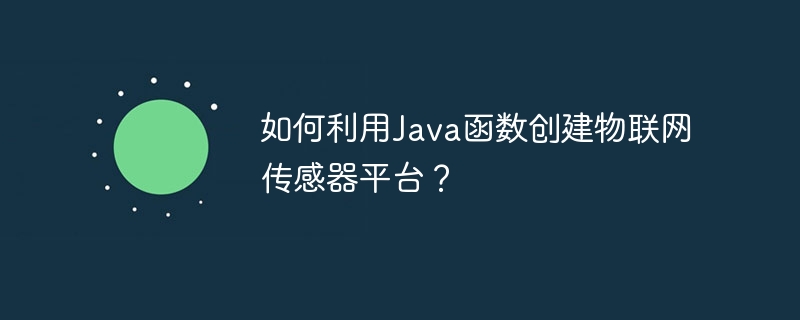Home >Java >javaTutorial >How to create an IoT sensor platform using Java functions?
How to create an IoT sensor platform using Java functions?
- PHPzOriginal
- 2024-04-28 22:15:011143browse
How to create an IoT sensor platform using Java functions: Use a Java function project, the IoT Core library, and write sensor processing functions to respond to events from IoT Core. Deploy the function and configure it to receive events from the device in the IoT Core dashboard. Connect the sensor and publish the data to the topic that triggers the function. View sensor data by viewing the function log. The platform scales easily as device connectivity increases.

How to use Java functions to create an IoT sensor platform
Introduction
With With the booming development of IoT devices, it is becoming increasingly important to build a platform to connect, manage and process these devices. Java Functions provides an ideal framework for creating such a platform because it provides the flexibility and scalability of a serverless computing environment.
In this tutorial, you'll learn how to create an IoT sensor platform using Java functions and Google Cloud IoT Core.
Prerequisites
- Java Development Kit (JDK) installed
- Cloud SDK
- Google Cloud IoT Core Account
Steps
1. Create a Java function project
Use the following command to create a new Java function Project:
gcloud functions init my-sensor-platform --runtime java11
2. Install the IoT Core library
Add the IoT Core dependency in Maven:
<dependency> <groupId>com.google.cloud</groupId> <artifactId>google-cloud-iot</artifactId> <version>1.160.2</version> </dependency>
3. Write the sensor Handling function
Create a Java function class named SensorEventHandler.java:
import com.google.cloud.functions.BackgroundFunction;
import com.google.cloud.functions.Context;
import com.google.common.io.BaseEncoding;
import com.google.gson.Gson;
import com.google.gson.JsonElement;
import functions.eventpojos.CloudEvent;
import functions.eventpojos.IotCoreEventData;
import java.nio.charset.StandardCharsets;
public class SensorEventHandler implements BackgroundFunction<CloudEvent> {
private static final Gson gson = new Gson();
@Override
public void accept(CloudEvent event, Context context) {
IotCoreEventData eventData = gson.fromJson(event.getData().toString(), IotCoreEventData.class);
String payload = new String(
BaseEncoding.base64().decode(eventData.getBinaryData().getBytes(StandardCharsets.UTF_8)),
StandardCharsets.UTF_8);
System.out.println("Received payload: " + payload);
}
}This function accepts CloudEvent from IoT Core and extracts and prints the event data.
4. Deploy the function
Use the following command to deploy the function:
gcloud functions deploy SensorEventHandler
5. Configure IoT Core
In the IoT Core dashboard, create a new device:
- Name the device and select the device type.
- In the "Connections" tab, select "Cloud Functions".
- Provide the name of the cloud function.
- Save the device.
Practical case
Connect the sensor
Connect an IoT sensor and register it to your device . Poll the sensor to publish data to a Cloud Pub/Sub topic that has been configured to trigger your cloud function.
View sensor data
In the Cloud Functions log, you will see the sensor data output by the function.
Scalability
As more sensor devices are connected, you can easily scale your platform simply by deploying more function instances.
Conclusion
Using Java functions to create an IoT sensor platform is a fast, scalable, and cost-effective solution. This platform makes it easy to connect, manage, and process data from a variety of IoT devices.
The above is the detailed content of How to create an IoT sensor platform using Java functions?. For more information, please follow other related articles on the PHP Chinese website!
Related articles
See more- What is the Internet of Things?
- What are the applications of the Internet of Things in the agricultural field?
- What is the core and foundation of the Internet of Things
- What is the communication method between things and things and between things and people in the Internet of Things?
- Implementation method of data collection and analysis of Internet of Things devices

